The 10 Unhealthiest Nut Butters on Grocery Shelves
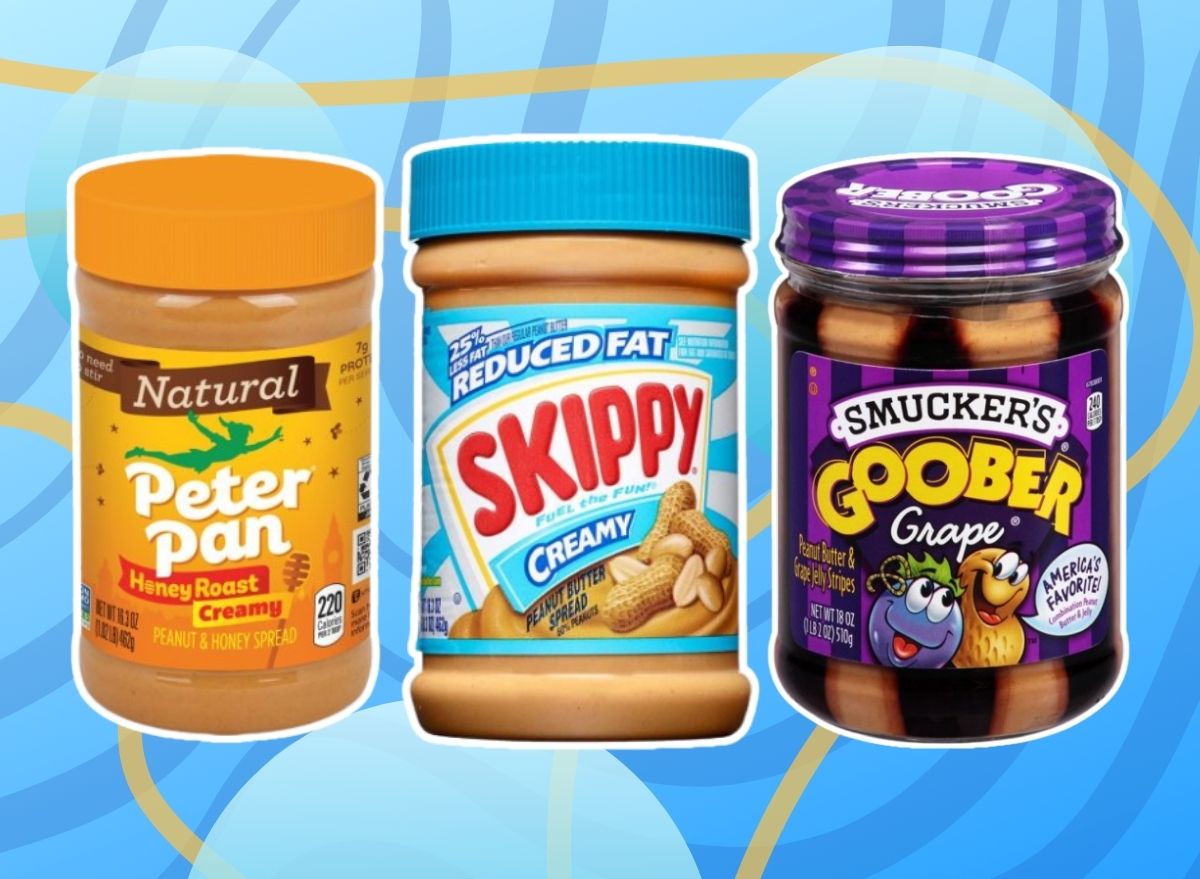
Gone are the days when the only jelly accompaniments on grocery store shelves were jars of plain peanut butter. From elaborate add-ins such as honey and maple syrup to chocolate and toffee bits, nut butters have undergone a glow-up over the years—but not necessarily in terms of health.
"Nut butter, when chosen correctly, provides a rich source of healthy fats such as omega-3s, which help to reduce cholesterol, blood pressure, and heart disease risk," says Courtney Pelitera, MS, RD, CNSC, a dietitian with Top Nutrition Coaching. "The healthy fats also help with food satisfaction and fullness, leading to less snacking throughout the day and more enjoyment of meals."
But flavored nut butter, or those riddled with extra ingredients, often contribute added sugars and hydrogenated oils, which don't confer the heart-health benefits we're after. "When choosing a nut butter, one of the first places to look is the ingredient list or the nutrition label. Generally speaking, the fewer the ingredients, the less processed the product is, and the more likely it will be free of hydrogenated vegetable oils," says Lena Bakovic, MS, RDN, CNSC, a dietitian with Top Nutrition Coaching.
Hydrogenated oils can increase bad LDL cholesterol levels and decrease good HDL cholesterol levels. "If an ingredient listed on the nut butter contains the word 'hydrogenated,' it is a sure sign that the nut butter is not heart-healthy," Bakovic says. You'll also want to watch out for different words for sugar such as dextrose, corn syrup, or high fructose corn syrup, Bakovic adds.
Below, we've rounded up the unhealthiest nut butter on grocery store shelves. Try avoiding these and stock up on these 15 Healthiest Nut Butters on Grocery Shelves instead.
Smucker's Goober Grape PB&J Stripes
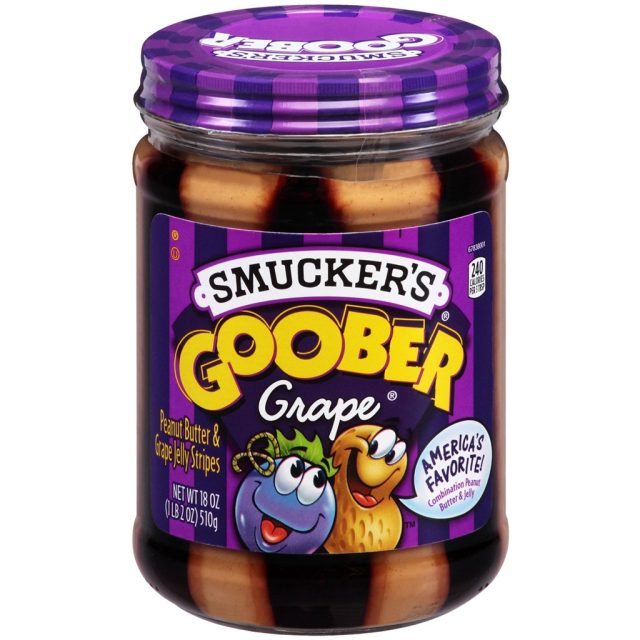
Calories: 220
Fat: 11 g (Saturated fat: 2.5 g)
Sodium: 125 mg
Carbs: 30 g (Fiber: 2 g, Sugar: 21 g)
Protein: 5 g
Out of jelly? This jar features layers of PB and grape jelly, so you'll never have to crack open two different jars to make your go-to sandwich. But this jelly-peanut butter combo contains numerous sources of added sugars. "Some of the first ingredients listed on the ingredient list of this product are grape juice, high fructose corn syrup, corn syrup, and dextrose—all different words which mean the same thing: added sugars (and you'll get 18 grams per serving of 3 tablespoons)," Bakovic says. "The high added sugar content here is not ideal for the average child or adult, and can contribute to a caloric imbalance and weight gain."
B. Happy Go Lucky Peanut Butter, Milk Chocolate, Toffee + Rice Crispies
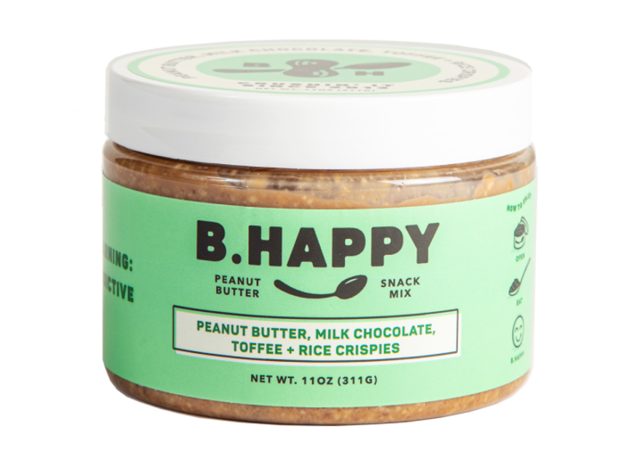
Calories: 180
Fat: 13 g (Saturated fat: 4 g)
Sodium: 75 mg
Carbs: 13 g (Fiber: 2 g, Sugar: 9 g)
Protein: 5 g
Not your average peanut butter, this pick's ingredient list is significantly longer thanks to fun toppings such as toffee, roasted almonds, rice krispies, and traditional peanuts and peanut oil. "The peanuts used in this product are honey-roasted peanuts, to begin with, so we are already starting with additional added sugars before the extra mix-ins are added," Pelitera says. "This product is higher in saturated fat and lower in protein than traditional peanut butter, and it should really be treated as more of a dessert."
Jif Reduced Fat Creamy Peanut Butter
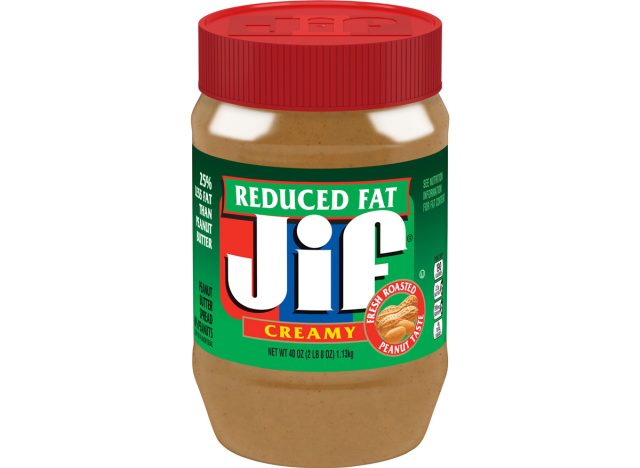
Calories: 190
Fat: 12 g (Saturated fat: 2.5 g)
Sodium: 190 mg
Carbs: 15 g (Fiber: 2 g, Sugar: 4 g)
Protein: 7 g
Just because "reduced fat" is plastered on the label, doesn't mean that this PB is healthy. This jar is made up of just 60% peanuts, and most of the other ingredients are additives and emulsifiers, which contributes to the reduced fat content, Pelitera says. "The JIF Reduced Fat Peanut Butter contains fully hydrogenated oils, which have been found to increase LDL (bad cholesterol) and decrease HDL (good cholesterol)—a reason to avoid them whenever possible," Pelitera says. Similarly, it also contains mono and diglycerides, which are found naturally in palm, sunflower, and soybean oils. "These are used to prevent the separation of oils in a product such as peanut butter and to improve the overall texture of the product. While there is currently no recommended limit on mono and diglycerides, they are still a processed fat, and we would likely benefit from limiting consumption as much as possible."
Skippy Natural Peanut Butter With Honey
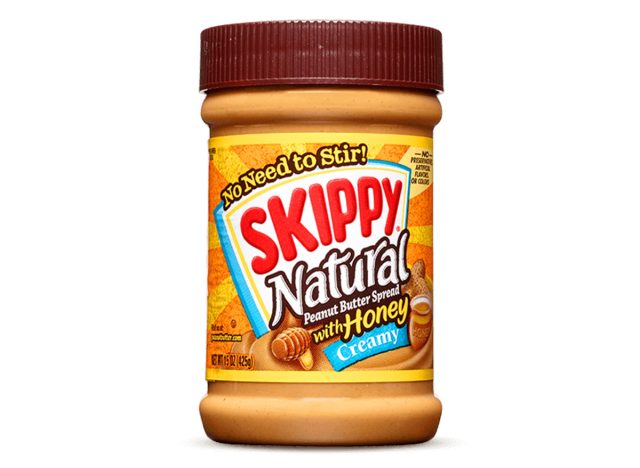
Calories: 200
Fat: 16 g (Saturated fat: 3.5 g)
Sodium: 140 mg
Carbs: 9 g (Fiber: 2 g, Sugar: 5 g)
Protein: 6 g
This nut butter contains sources of both added sugars and salt—two nutrients that aren't good for heart health in excess. Salt, sugar, and honey are all listed in descending order on the ingredient list of this product. This Skippy Peanut Butter also contains palm oil, likely added to help with the consistency of the product. "Palm oil is high in saturated fat content, which can have negative effects on serum cholesterol levels and heart disease risk," Bakovic says.
B. Happy Joy to the World Peanut Butter, Cranberries, White Chocolate + Dark Chocolate
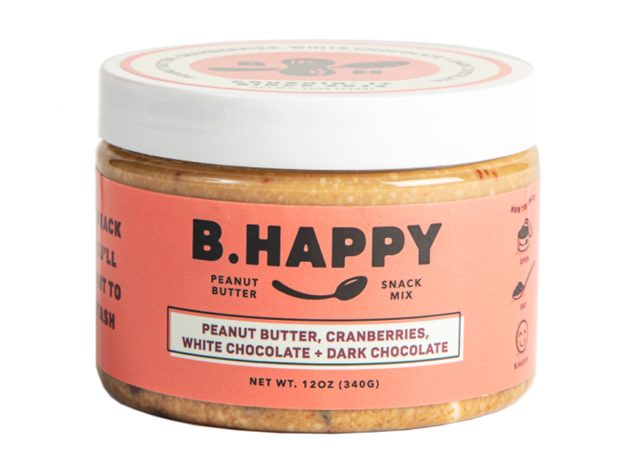
Calories: 170
Fat: 13 g (Saturated fat: 3 g)
Sodium: 70 mg
Carbs: 13 g (Fiber: 2 g, Sugar: 10 g)
Protein: 5 g
Fun toppings like white and dark chocolate chips contribute loads of flavor as well as a total of 9 grams of added sugar per two tablespoons. "Ingredients such as honey and chocolate chips contribute to the sugar content, increasing the caloric density of this product, which may contribute to difficulty with weight management if there is already a caloric surplus in one's diet," Bakovic says.
Skippy Reduced Fat Peanut Butter
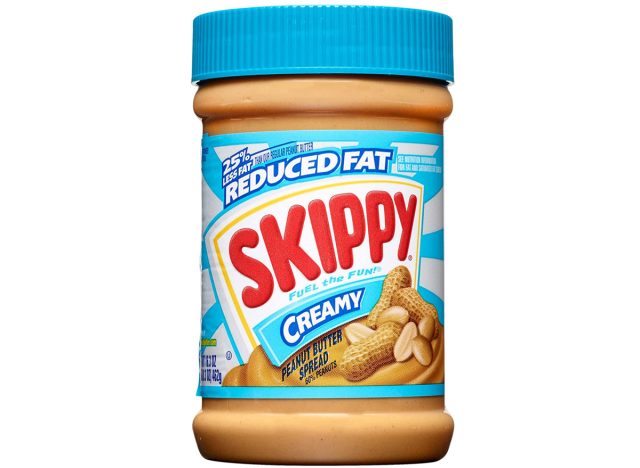
Calories: 190
Fat: 12 g (Saturated fat: 2 g)
Sodium: 170 mg
Carbs: 14 g (Fiber: 2 g, Sugar: 4 g)
Protein: 7 g
"Reduced fat" isn't synonymous with healthy—just take a look at this jar's ingredient list. This nut butter contains hydrogenated vegetable oil, which "has negative implications on blood cholesterol and triglyceride levels and may increase the risk of cardiovascular illness," Bakovic says. So why's it added to nut butter in the first place? "Hydrogenated vegetable oil is sometimes used by the food industry to prevent separation of the product ensuring its smooth texture as well as to extend the shelf life of the product," Bakovic says.
Peanut Butter & C0. White Chocolatey Wonderful
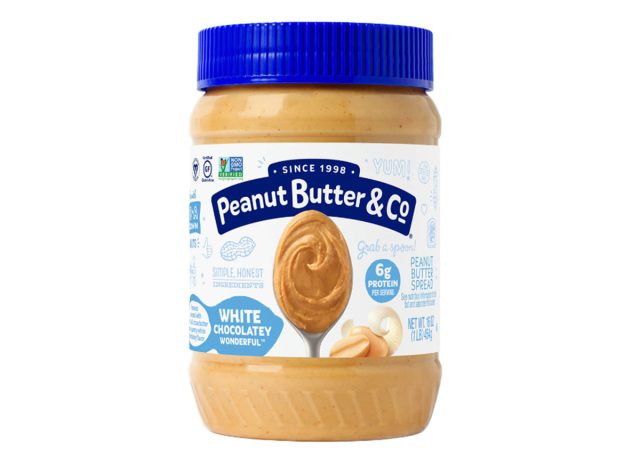
Calories: 180
Fat: 13 g (Saturated fat: 3 g)
Sodium: 35 mg
Carbs: 12 g (Fiber: 2 g, Sugar: 7 g)
Protein: 6 g
White chocolate-swirled peanut butter may sound like the perfect snack to spoon into. Though, one 2-tbsp serving contains 6 grams of added sugars plus palm oil. "Palm oil is high in saturated fat, which contributes to an increased risk of high triglyceride levels and cardiovascular disease," Pelitera says.
Peter Pan Honey Roasted Peanut Butter
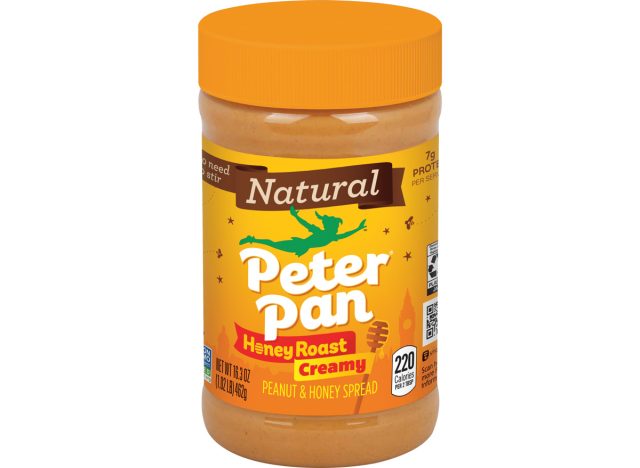
Calories: 200
Fat: 14 g (Saturated fat: 3 g)
Sodium: 130 mg
Carbs: 11 g (Fiber: 2 g, Sugar: 8 g)
Protein: 7 g
Although the label reads "honey roasted," this peanut butter is made with multiple different types of added sugars. You'll get molasses, sugar, and honey for a combined total of 7 grams of added sugars per serving. "A healthier option would be to choose a nut butter with a single ingredient (just nuts), and then drizzle with a little bit of natural honey of your own," Pelitera says.
Great Value Creamy Peanut Butter
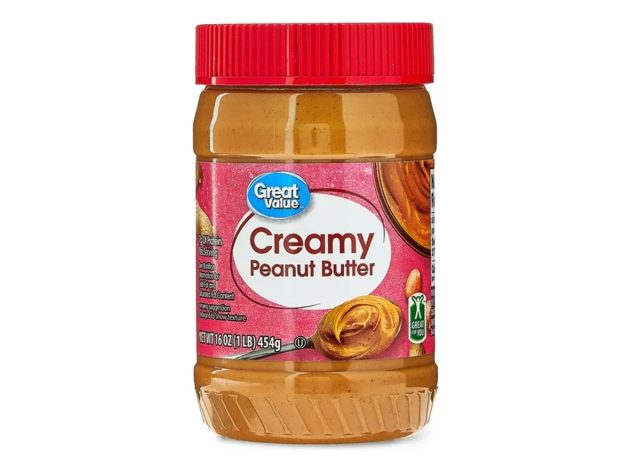
Calories: 180
Fat: 15 g (Saturated fat: 2.5 g)
Sodium: 135 mg
Carbs: 8 g (Fiber: 2 g, Sugar: 4 g)
Protein: 7 g
The Great Value Peanut Butter contains hydrogenated vegetable oils, enough that the total fat content is higher compared to similar products at 17 grams of fat per serving, Bakovic says. The fat in your peanut butter should be coming from just peanuts—not hydrogenated vegetable oils. Peanuts are made up of monounsaturated fats, which are beneficial for heart health by helping balance LDL and HDL cholesterol levels in our blood, Bakovic says.
Peanut Butter & Co Mighty Maple
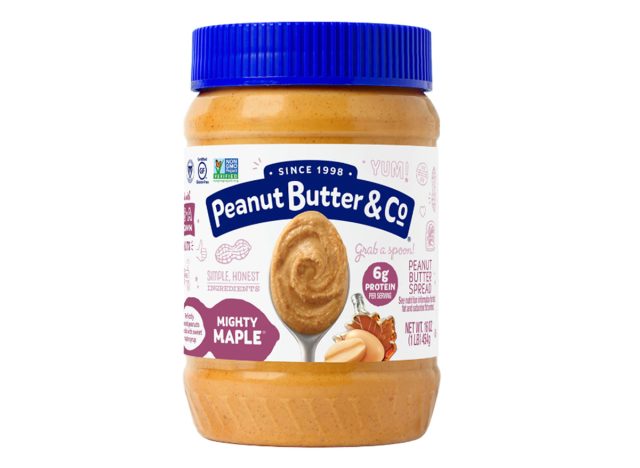
Calories: 180
Fat: 13 g (Saturated fat: 2.5 g)
Sodium: 60 mg
Carbs: 11 g (Fiber: 2 g, Sugar: 7 g)
Protein: 6 g
This maple-spiked peanut butter may seem like the perfect waffle and pancake topping, but you'll want to go easy on this spread. "Some of the first ingredients are cane sugar and maple syrup—both of these are sources of added sugars," Bakovic points out. Eating a diet high in added sugars can contribute to weight gain, she says, adding that they're especially troublesome for people with blood sugar issues. "Added sugars are not optimal for people living with diabetes in that they increase blood sugar levels and can make diabetes management more challenging."
- Source: Jain AP, Aggarwal KK, Zhang PY. Omega-3 fatty acids and cardiovascular disease. Eur Rev Med Pharmacol Sci. 2015;19(3):441-5. PMID: 25720716.
- Source: Trans fat is double trouble for heart health. (2022b, February 23). Mayo Clinic. https://www.mayoclinic.org/diseases-conditions/high-blood-cholesterol/in-depth/trans-fat/art-20046114
- Source: Consuming high amounts of saturated fats linked to increased heart disease risk. (2018, June 22). News. https://www.hsph.harvard.edu/news/press-releases/saturated-fats-increased-heart-disease-risk/
- Source: Siri-Tarino, P. W., Sun, Q., Hu, F. B., & Krauss, R. M. (2010). Saturated fat, carbohydrate, and cardiovascular disease. the American Journal of Clinical Nutrition, 91(3), 502–509. https://doi.org/10.3945/ajcn.2008.26285
- Source: Ikehara, S., Iso, H., Kokubo, Y., Yamagishi, K., Saito, I., Yatsuya, H., Kimura, T., Sawada, N., Iwasaki, M., & Tsugane, S. (2021). Peanut consumption and risk of stroke and ischemic heart disease in Japanese men and women: the JPHC study. Stroke (1970), 52(11), 3543–3550. https://doi.org/10.1161/strokeaha.120.031212









